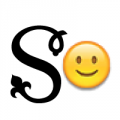Single-descender Cyrillic de
Adam Jagosz
Posts: 690

Oksana overall strikes me as a charming design, but I've been curious about some of its solutions. Most notably, the single-descender de – is that a done thing? is it meant as an intermediary form between print and handwriting?
I'm also intrigued by the hard sign which seems efficient, spacing-wise.
Tagged:
1
Comments
-
Whoa! That hard sign certainly is interesting. I am curious as to just how rare that solution is?0
-
That hard sign construction is conventional in italics, so translates quite well to an informal type with elements of hand lettering.

4 -
As a “semi serif” style, this typeface emphasizes that those dangly bits on /De and /de are not descenders, but serifs. Indeed, one finds their complete absence in much sans serif poster lettering of the early Soviet era. For instance, this famous 1925 one by Alexander Rodchenko:
 7
7 -
I have noticed it in some of our books. It seems like a design decision to me, not an ortographic one. Maybe the left-side descender would make the letter too detailed. I have no idea what the author was thinking.3
-
Does a Д trimmed like that it evoke similar feelings as Rotis Semi Serif?
 @Nick Shinn I see that Ц cannot have the same treatment on its sole dangly bit? That’s a shame as those dangly bits are one of the most ungainly features of Cyrillic overall, in my opinion, making it harder to set type more tightly. And looking at all the extraterrestrial additions like ҖҚҠҢӶҜҤҶӋҸ (some of these letters, I think, representing the same sound in various languages), they were like “were can I squeeze more bits”.0
@Nick Shinn I see that Ц cannot have the same treatment on its sole dangly bit? That’s a shame as those dangly bits are one of the most ungainly features of Cyrillic overall, in my opinion, making it harder to set type more tightly. And looking at all the extraterrestrial additions like ҖҚҠҢӶҜҤҶӋҸ (some of these letters, I think, representing the same sound in various languages), they were like “were can I squeeze more bits”.0 -
Adam Jagosz I see that Ц cannot have the same treatment on its sole dangly bit?Yes, Rodchenko barely admits it in the poster above. The best that can be said is that its small size harmonizes with the tiny kink that distinguishes K from H, and the little pointed “v” of M.
The corresponding ungainly elements of roman caps are the tails of J and Q, but there are many comfortable above-the-baseline ways to handle those.2 -
While it's not easy to find the simple logic behind it, I would say:
Yes, for some reason Д can easily live without these descending strokes, while Ц can't
On some occasions, Д can go even without horizontal extensions on the baseline, looking like a plain triangle (like Greek Δ) in that case.
On the other side, I agree with Vasil, if they are present (which is the case in the vast majority of typefaces), they are an integral part of the "default orthographic shape" present both in serif and sans-serif styles.
In handwriting, I usually don't make the left descending stroke but only the right one (and I make it diagonal not vertical), because these descending parts are indeed tiring when writing longer text
5 -
No. It’s just a designer’s decision - because it’s better in that specific font. Cyrillic handwriting -д- is similar latin -g-. But options are possibleAdam Jagosz said:is it meant as an intermediary form between print and handwriting?
Probably, all the same should correspond to the style of the font. There ar times when reducing certain glyph elements in a particular style is generally beneficial. By the way, removing dangling elements from Дд is a very popular solution when designing logos.Igor Petrovic said:
they are an integral part of the "default orthographic shape" present both in serif and sans-serif styles.
The result of forced Cyrillization / creation of a writing system of the times of the USSR for non-Slavic languages. Therefore, there should be no question why, in some cases, there is a return to the Latin alphabet - Moldova, Azerbaijan, Uzbekistan, Turkmenistan, Kazakhstan...Adam Jagosz said:And looking at all the extraterrestrial additions like ҖҚҠҢӶҜҤҶӋҸ (some of these letters, I think, representing the same sound in various languages), they were like “were can I squeeze more bits”.3 -
That's what I meant. The g form has, conincidentally, a descender dangling from the right (since we've established in Д, when present, it's an orthographic feature, I will not call it a serif, sorry!). But I guess I'm weird like that trying to find relationships like this. However now that Igor mentions he does write Д like this...Olexa Volochay said:
No. It’s just a designer’s decision - because it’s better in that specific font. Cyrillic handwriting -д- is similar latin -g-. But options are possibleAdam Jagosz said:is it meant as an intermediary form between print and handwriting?

0 -
Adam Jagosz said:That's what I meant. The g form has, conincidentally, a descender dangling from the right (since we've established in Д, when present, it's an orthographic feature, I will not call it a serif, sorry!). But I guess I'm weird like that trying to find relationships like this. However now that Igor mentions he does write Д like this...

 Sry, I overlooked the fact that my handwriting is very similar to the upright letterforms instead of cursive forms which people usually use in handwriting.
Sry, I overlooked the fact that my handwriting is very similar to the upright letterforms instead of cursive forms which people usually use in handwriting.
Thanks to Olexa for mentioning g form in this context While there might be exceptions/variants g form is cursive form while small-cap д is the usual upright letterform.
While there might be exceptions/variants g form is cursive form while small-cap д is the usual upright letterform.
In Serbia, we use the term "PRINTED LETTERS" for upright letterforms no matter are they printed or handwritten. In contrast, "WRITTEN LETTERS" are cursive/connected/script-style letterforms (again no matter are they printed or written, it's the term for letter shape style) and they can be slanted or not.
The small-cap д is "PRINTED LETTER" while g form is "WRITTEN LETTER"
So I would say that д without left descending stroke in your example is "PRINTED LETTER" with the influence of the look of "PRINTED LETTERS" when written by hand, which is exactly how I write I omit the left descending stroke to speed up writing. 3
I omit the left descending stroke to speed up writing. 3
Categories
- All Categories
- 46 Introductions
- 3.9K Typeface Design
- 487 Type Design Critiques
- 563 Type Design Software
- 1.1K Type Design Technique & Theory
- 656 Type Business
- 861 Font Technology
- 29 Punchcutting
- 520 Typography
- 119 Type Education
- 324 Type History
- 77 Type Resources
- 112 Lettering and Calligraphy
- 33 Lettering Critiques
- 79 Lettering Technique & Theory
- 558 Announcements
- 94 Events
- 114 Job Postings
- 170 Type Releases
- 179 Miscellaneous News
- 276 About TypeDrawers
- 54 TypeDrawers Announcements
- 120 Suggestions and Bug Reports





